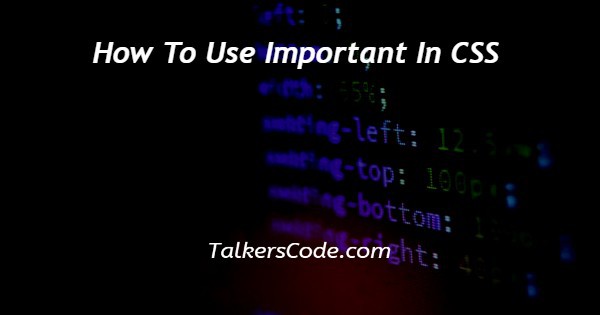In this tutorial we will show you how to use important in CSS, when styling your website, you can use numerous CSS declarations on the same element. The browser then assesses which declarations are most relevant to an element and applies them.
The relevance or specificity of CSS selectors is determined by their matching rules. CSS selectors tell a browser which items to design with CSS. There are several sorts of selectors, each with its own syntax and level of granularity.
There is, however, an exception to the CSS specificity restrictions. It is called an! important rule. In this tutorial, we will check out how to use important in CSS.
Step By Step Guide On How To Use Important In CSS :-
In CSS, the !important property is used to give property more weight (importance) than a regular property.
The !important keyword in CSS means "this is important," so disregard all other rules and apply the!important rule instead.
An example of how to use important in CSS is shown below.
<!DOCTYPE html>
<html>
<head>
<title></title>
<style>
h1 {
color: red ;
}
h1 {
color: #blue !important; //important property
}
</style>
</head>
<body>
<h1>This is a sample text</h1>
</body>
</html>
- To begin, type <! DOCTYPE html>, which tells the web browser that the file is in HTML format.
- The < html> element, on the other hand, is used to signal the start of HTML content.
- The < head> tag now contains the information about web pages. The <title> element is used in this tag to provide a web page title. A good example of paired tags is the <head> and <title> tags. As a result, both have the </head> and </title> closing tags.
- A <style> tag was utilised in the head tag. The <h1> tag's normal colour was red in the example above, but because of the !important property, blue colour was used.
- The <body> element is used to define the content of a webpage. This is where all of the stuff for the website will be written. Over here, we've defined the <h1> tag.
- The </body> and </html> tags are used to close the <body> and <html> tags, respectively.
CSS Important Isn't Working for a Few Reasons :-
Let's say you use the !important rule in your CSS, but the elements don't appear to be styled correctly. Only a few circumstances exist in which the !important rule would fail.
First, if the !important rule is used in the user's stylesheet, it will not work in the author's stylesheet. The author stylesheet is provided by the web page's author. The user stylesheet is provided by the browser's user.
CSS rules in an author's stylesheet take precedence over those in a user's stylesheet by default. !important rules in a user stylesheet, on the other hand, will override !important rules in the author's stylesheet to create a balance of power between authors and users.
This CSS feature was created with accessibility in mind. Users with vision difficulties can maintain control over the presentation of a web page by using larger letters, specific colour combinations, or other criteria.
Conclusion :-
While !important declarations should be used sparingly in code, it's still important to know what they are and how to use them.
In your user stylesheets, you might need to use the !important rule. Understanding the !important attribute is an essential step in learning HTML and CSS.
Follow the above steps to know how to use important in CSS. I hope this tutorial on how to use important in CSS helps you.














